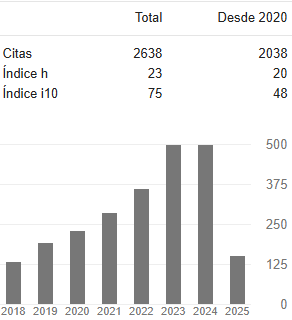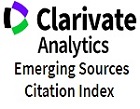Modelos de crecimiento de grietas por fatiga
DOI:
https://doi.org/10.31908/19098367.582Palabras clave:
mecánica de fractura, fatiga, crecimiento de grietas, Ley de Paris, microgrietas, macrogrietas, elementos finitosResumen
Este artículo estudia los diferentes modelos de crecimiento de grietas por fatiga, exponiendo una breve descripción histórica. Siguiendo la línea cronológica en el desarrollo de la investigación, hace especial énfasis en la ley de Paris y luego estudia algunos modelos específicos que, en general, corresponden a investigaciones de punta realizadas por diversos grupos, en el ámbito internacional. El objetivo principal es analizar y discutir las ventajas y desventajas de los diferentes modelos, teniendo en cuenta condiciones como la facilidad de aplicación, la disponibilidad de datos y la validez con respecto a los resultados experimentales.
Descargas
Referencias
R. L. Norton, Diseño de Máquinas, 4ª ed. Mexico: Ed. Prentice-Hall (Pearson), 2011.
W. Schutz, A History of Fatigue, Ottobrun, Germany: Elsevier, 1996, p. 2.
A. Wohler, “Test to determinate the forces acting on railway carriage axles and capacity of resistance of the axle,” Enginering, vol. 11, 1871.
H. Geber, “Bestimmung der zulässigen spannungen in eisenkonstruktionen (Determinación de los esfuerzos admisibles en estructuras de hierro),” Z. Bayer Arch. Ingenieur-Vereins, vol. 6, 1874, pp. 101-110.
J. Goodman, Mechanics Applied to Engineering, London: Longmans, Green & Co., 1899.
K. L. Richards, Design Engineer´s Handbook, Washington D.C.: CRC Press, Taylor and Francis Group, 2013.
A. A. Griffith, “The phenomena of rupture and flow in solids,” Philosophical Transactions of Royal Society of London, Series A, vol. 221, 1921, pp. 163-198.
S. S. Manson y G. R. Halford, Fatigue and Durability of Structural Materials, United States of America: ASM International, 2006.
A. G. Palmgren, “Die lebensdauer von kugellargern (Durability of ball bearing),” VDI-Zeitschrift des Vereines Deutscher Ingenieure, vol. 68 (14), 1924, pp. 339-341.
M. A. Miner, “Cumulative damage in fatigue,” J. Appl. Mech., vol. 67, 1945, pp. A159-A164.
W. Weibull, Fatigue Testing and Analysis of Results, Belfast: Pergamon Press, 1961.
W. Weibull, “A statical distribution function of wide applicability,” J. Appl. Mech., vol. 18, 1951, pp. 293-297.
G. R. Irwin, “Analyisis of stresses and strains near the end of crack traversing a plate,” J. Appl. Mech., vol. 24, 1957, pp. 361-364.
S. S. Manson, “Fatigue: a complex subject-some simple approximations”, Exp. Mech., vol. 5 (4), 1965, pp. 193-226.
H. Neuber, “Theory of stress concentration for shear-strained prismatical bodies with arbitrary nonlinear stress-strain law,” J. Appl. Mech., vol. 28 (4), 1961, pp. 544-560.
R. E. Peterson, “Notch Sensitivity,” in Metal Fatigue, G. Sines & J. L. Waisman, Eds. New York: McGraw-Hill, 1959, pp. 293-306.
E. Z. Stowell, “Stress and strain concentration in a circular hole in an infinite plate,” Naca Tech., Washington, D.C., Tech. Note 2073, 1950.
P. Paris y F. Erdogan, “A critical analysis of crack propagation laws,” J. Fluids Eng., vol. 85 (4), 1963, pp. 528-533.
R. W. Hertzberg, Deformation and Fracture Mechanics of Engineering Materials, 4th ed., U.S.A.: John Wiley & Sons, Inc., 1996.
S. Pearson, “Initiation of fatigue cracks in commercial aluminium alloys and the subsequent propagation of very short cracks,” Eng. Frac. Mech., vol. 7 (2), 1975, pp. 235-240.
H. Kitagawa y S. Takahashi, “Applicability of fracture mechanics to very small cracks,” in Proc. ASM: Int. Conf. Mech. Behaviour Mat., Metalspark, Ohio, 1976, pp. 627-631.
R. Jones, L. Molent y S. Pitt, “Crack growth of physically small cracks,” Int. J. Fatigue, vol. 29 (9-11), 2007, pp 1658-1667.
C. Vallellano Martin, “Crecimiento de grietas pequeñas por fatiga en componentes con concentradores de tensión,” Tesis de Ph.D., Esc. Téc. Sup. Ing. Ind., Univ. Sevilla, Sevilla, 1998.
C. Vallellano, J. Vázquez, A. Navarro y J. Domínguez, “Modelo micromecanico de crecimiento de grietas pequeñas por fatiga: una aproximacion basada en dos condiciones umbrales,” Ana. Mecanica de Fractura, vol. 25, 2008, pp. 349-354.
N. Pugno, M. Ciavarella, P. Cornetti y A. Carpinteri, “A generalized Paris’ law for fatigue crack growth,” J. Mech. Phys. Solids, vol. 54 (7), 2006, pp. 1333-1349.
R. Branco, F. V. Antunes, J. A. Martins Ferreira y J. M. Silva, “Determination of Paris law constants with a reverse engineering technique,” Eng. Failure Analysis, vol. 16 (2), 2009, pp. 631-638.
C. Laird, “The Influence of metallurgical structure on the mechanisms of fatigue crack propagation,” Fatigue Crack Propagation ASTM Special Technical Publication 415, 1967, pp. 131-168.
J. Geathers, C. J. Torbet, J. W. Jones y S. Daly, “Investigating environmental effects on small fatigue crack growth in Ti–6242S using combined ultrasonic fatigue and scanning electron microscopy,” Int. J. Fatigue, vol. 70, 2015, pp. 154-162.
A. Turnbull, S. Zhou y M. Lukaszewicz, “Environmentally assisted small crack growth,” Procedia Materials Science, vol. 3, 2014, pp. 204-208.
G. J. Deng, S. T. Tu, Q. Q. Wang, X. C. Zhang y F. Z. Xuan, “Small fatigue crack growth mechanisms of 304 stainless steel under different stress levels,” Int. J. Fatigue, vol. 64, 2014, pp. 14-21.
G. M. Owolabi y H. A. Whitworth, “Modeling and simulation of microstructurally small crack formation and growth in notched nickel-base superalloy component,” J. Materials Sc. & Tech., vol. 30 (3), 2014, pp. 203-212.
Y. Zhang, H.-J. Shi, J. Gu, C. Li, K. Kadau y O. Luesebrink, “Crystallographic analysis for fatigue small crack growth behaviors of a nickel-based single crystal by in situ SEM observation,” Theo. and App. Frac. Mech., vol. 69, 2014, pp. 80-89.
M. Ciavarella, M. Paggi y A. Carpinteri, “ One, no one, and one hundred thousand crack propagation laws: A generalized Barenblatt and Botvina dimensional analysis approach to fatigue crack growth,” J. Mech. Phys. Solids, vol. 56 (12), 2008, pp. 3416-3432.
B. Farahmand y K. Nikbin, “Predicting fracture and fatigue crack growth properties using tensile properties,” Eng. Frac. Mech., vol. 75 (8), 2008, pp. 2144-2155.
B. E. K. Hachi, S. Rechak, M. Haboussi, M. Taghite y G. Maurice, “Fatigue growth of embedded elliptical cracks using Paris-type law in a hybrid weight function approach,” Comptes Rendus Mécanique, vol. 336 (4), 2008, pp. 390-397.
L. Molent, M. McDonald, S. Barter y R. Jones “Evaluation of spectrum fatigue crack growth using variable amplitude data,” Int. J. Fatigue, vol. 30 (1), 2008, pp. 119-137.
N. E. Frost, K. J. Marsh y L. P. Pook, Metal Fatigue, Oxford: Oxford University Press, 1974.
N. E. Frost y D. S. Dugdale, “The propagation of fatigue cracks in sheet specimens,” J. Mech. Phys. Solids, vol. 6 (2), 1958, pp. 92-110.
J. Polak y P. Zezulka, “Short crack growth and fatigue life in austeniticferritic duplex stainless steel,” Fatigue Fracture Eng. Mat. Struc., vol. 28 (10), 2005, pp. 923-935.
W. Elbert, “The significance of fatigue crack closure,” ASTM STP, vol. 486, 1971, pp. 230-243.
D. Kujawski, “ HYPERLINK “http://www.sciencedirect.com/ science/article/pii/S0142112301000238” A new (ΔK+ Kmax)0.5 driving force parameter for crack growth in aluminum alloys ,” Int. J. Fatigue, vol. 23 (8), 2001, pp. 733-740.
X. Huang y T. Moan, “Improved modeling of the effect of R-ratio on crack growth rate,” Int. J. Fatigue, vol. 29 (4), 2007, pp. 591-602.
S. Stoychev y D. Kujawski, “Analysis of crack propagation using K and Kmax,” Int. J. Fatigue, vol. 27, 2005, pp. 1425-1431.
N. Pugno, P. Cornetti y A. Carpinteri, “New unified laws in fatigue: from the Wöhler´s to the Paris´ regime,” Eng. Frac. Mech., vol. 74, 2007, pp. 595-601.
S. Dinda y D. Kujawski, “Correlation and prediction of fatigue crack growth for different R-ratios using Kmax and K+ parameters,” Eng. Frac. Mech., vol. 71, 2004, pp. 1779-1790.
V. B. Watwood Jr., “The finite method for prediction of crack behavior,” Nuclear Eng. Design, vol. 11 (2), 1970, pp. 323-332.
R. Jones, L. Molent y K. Krishnapillai, “An equivalent block method for computing fatigue crack growth,” Int. J. Fatigue, vol. 30, 2008, pp. 1529-1542.
I. V. Singh, B. K. Mishra, S. Bhattacharya y R. U. Patil, “The numerical simulation of fatigue crack growth using extended finite element method,” Int. J. Fatigue, vol. 36, 2012, pp. 109-119.
H. Pathak, A. Singh y I. V. Singh, “Fatigue crack growth simulations of 3-D problems using XFEM,” Int. J. Mech. Sc., vol. 76, 2013, pp. 112-131.
N. Ranganathan, F. Chalon y S. Meo, “Some aspects of the energy based approach to fatigue crack propagation,” Int. J. Fatigue, vol. 30, 2008, pp. 1921-1929.
T. Belytschko y T. Black, “Elastic crack growth in finite elements with minimal remeshing,” Int. J. Num. Meth. Eng., vol. 45, 1999, pp. 601- 620.
N. Moës, J. Dolbow y T. Belytschko, “A finite element method for crack growth without remeshing,” Int. J. Num. Meth. Eng., vol. 46, 1999, pp. 131-150.
E. Giner, “Estimación del error de discretizacion en el cálculo del factor de intensidad de tensiones mediante elementos finitos.” Tesis de Ph.D., Dept. Ing. Mecánica y de Materiales, Univ. Politecnica Valencia, Valencia, 2001.
R. H. Gallagher, “A review of finite element techniques in fracture mechanics,” in Proc. 1st Int. Conf. Num. Meth. Frac. Mech., 1978, pp. 1-25.
S. K. Chan, I. S. Tuba y W. K. Wilson, “On the finite element method in linear fracture mechanics,” Eng. Frac. Mech., vol. 2 (1), 1970, pp. 1-17.
D. R. J. Owen y A. J. Fawkes, Enginering Fracture Mechanics: Numerical Methods And Applications, Swansea: Pineridge Press, 1983.
I. S. Raju y J. C. Newman Jr., “Stress-intensity factors for a wide range of semi-elliptical surface cracks in finite-thickness plates,” Eng. Frac. Mech., vol. 11, 1979, pp. 817-829.
J. R. Rice, “A Path independent integral and the approximate analysis of strain concentration by notches and cracks,” J. App. Mech., vol. 35 (2), 1968, pp. 379-386.
A. R. Maligno, S. Rajaratnam, S. B. Leen y E. J. Williams, “A threedimensional (3D) numerical study of fatigue crack growth using remeshing techniques,” Eng. Fract. Mech., vol. 77, 2010, pp. 94-111.
T. Rabczuk, S. Bordas y G. Zi, “On three-dimensional modelling of crack growth using partition of unity methods,” Comp. & Struc., vol. 88, 2010, pp. 1391-1411.
M. Nani Babu, C.K. Mukhopadhyay, G. Sasikala, B. Shashank Dutt, S. Venugopal, S. K. Albert, A.K. Bhaduri y T. Jayakumar, “Fatigue crack growth characterisation of RAFM steel using acoustic emission technique,” Procedia Engineering, vol. 55, 2013, pp. 722-726.
K-F. Nilsson, S. Ripplinger, A. Ruiz, M. Bruchhaussen, B. Fischer y M. Gupta, “Analysis of crack morphologies and patterns from thermal fatigue using X-ray tomography,” Procedia Materials Sciencie, vol. 3, 2014, pp. 2180-2186.
R. de Borst, “Numerical aspects of cohesive-zone models,” Eng. Fract. Mech., vol. 70, 2003, pp. 1743-1757.
B. Yang, S. Mall y K. Ravi-Chandar, “A cohesive zone model for fatigue crack growth in quasibrittle materials,” Int. J. Solids Structures, vol. 38, 2001, pp. 3927-3944.
A. Ural, V. R. Krishnan y K. D. Papoulia, “A cohesive zone model for fatigue crack growth allowing for crack retardation,” Int. J. Solids Structures, vol. 46, 2009, pp. 2453-2462, 2009.
J. Planas, M. Elices, G. V. Guinea, F. J. Gómez, D. A. Cendón y I. Arbilla, “Generalizations and specializations of cohesive crack models,” Eng. Fract. Mech., vol. 70, 2003, pp. 1759-1776.
P. Beaurepaire y G.I. Schueller, “Modeling of the variability of fatigue crack growth using cohesive zone elements,” Eng. Fract. Mech., vol. 78, 2011, pp. 2399-2413.
M. Elices, G. V. Guinea, J. Gómez y J. Planas, “The cohesive zone model: advantages, limitations and challengers,” Eng. Fract. Mech., 2002, vol. 69, pp. 137-163.
M. Elices, J. Planas, J. Llorc y G. Guinea, “Métodos Numéricos en la Fractura de Materiales Cohesivos ,” en Fractura Cohesiva. Madrid, España: Universidad Politécnica de Madrid, 2001.
Descargas
Publicado
Número
Sección
Licencia
Derechos de autor 2019 Entre Ciencia e Ingeniería

Esta obra está bajo una licencia internacional Creative Commons Atribución-NoComercial 4.0.



















